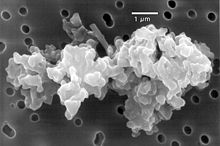Cosmic dust
Cosmic dust is dust in space . A distinction is made depending on its place or origin
- intergalactic dust
- interstellar dust
- interplanetary dust (which can be visible on Earth as zodiacal light )
- Circumplanetary dust , for example in planetary rings .
Cosmic dust also includes the water resources in the universe in the form of finely divided water ice (see also water synthesis in space ).
The earth captures about 30,000 tons of cosmic dust each year, most of which is interplanetary dust. The total captured cosmic matter (with gases) varies between about 150,000 and 1,000,000 tons per year.
See also
literature
- Genzel R & Cesarsky CJ, Extragalactic Results from the Infrared Space Observatory , Annual Review of Astronomy and Astrophysics 38: 761-814, 2000
- J. Binney & M. Merrifield, Galactic Astronomy (Princeton Series in Astrophysics) , 1998
- DCB Whittet, Dust in the Galactic Environment (Graduate Series in Astronomy)
- Mayo J. Greenberg: The cosmic dust connection. Kluwer, Dordrecht 1996, ISBN 0-7923-4365-4
- Gorden Videen: Optics of cosmic dust. Kluwer, Dordrecht 2002, ISBN 1-4020-0819-8
- Edmond Murad, Iwan P. Williams: Meteors in the earth's atmosphere - meteoroids and cosmic dust and their interactions with the earth's upper atmosphere. Cambridge Univ. Press, Cambridge 2002, ISBN 0-521-80431-0
Web links
Individual evidence
- ^ Bernd Herrmann: Contributions to the Göttingen Environmental History Colloquium 2009 - 2010 . Universitätsverlag Göttingen, 2010, ISBN 978-3-941875-52-4 , p. 110 ( books.google.de ).
